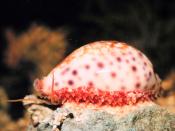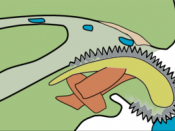Snails
The snail is a Geophila in the class Gastropoda, subclass Pulmonata. Snails are in the Mollusca, or Molluska phylum. There are about 75,000 species of Gastropods that live on land, in the sea, or in freshwater. The snail's cousins include oysters, octopi, squid, and clams. The snail is also closely related to the slug, being a Gastropod as well.
The word "Gastropod" means stomach-foot, because the foot of a gastropod is located near its stomach. Snails eat with a tongue-like organs called radulae. They are lined with small 'teeth' that help the snail scrape food off of surfaces. The recurved 'tooth' on the radula is hardened with iron and silicon oxides at its tip. Snails eat mostly living as well as decaying plants.
The snail moves on a broad, slimy foot that oozes a mucous-like substance to make it easier to move. The slimy, silvery trail often seen behind snails and slugs is this substance.
The substance comes out of the front of the snail and gels on contact with air. The snail can move on very sharp or pointed surfaces because the slime helps protect its soft underside. A snail can even crawl across a razorblade! Some snails have feet almost as tall as their shells.
Snails have soft, unsegmented bodies with a hard shell for protection. The shell has one or more whorls to reduce the chance of shattering. Many snails have more than one whorl, such as the Cylindrical Whorl Snail, which has a body whorl as well as many suture whorls. It even has a tipped protoconch for extra protection. Snails also have a mantle under the shell to protect the internal organs from damage. The snail has two pairs of tentacles on its head. The longer pair is for seeing, while the shorter...


